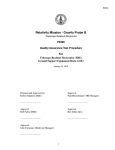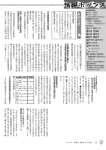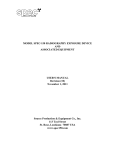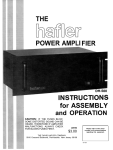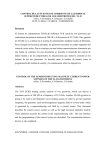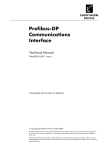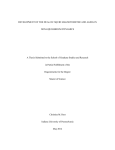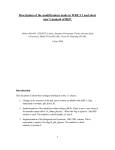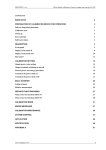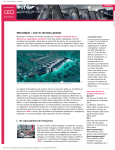Download TRUBA User Manual - Laboratorio Nacional de Fusión
Transcript
Informes Técnicos Ciemat
1134
Febrero, 2008
TRUBA User Manual
M. A. Tereshchenko
F. Castejón
A. Cappa
Asociación EURATOM / CIEMAT para Fusión - 108
Laboratorio Nacional de Fusión por Confinamiento Magnético
Toda correspondencia en relación con este trabajo debe dirigirse al Servicio de Información y Documentación, Centro de Investigaciones Energéticas, Medioambientales y
Tecnológicas, Ciudad Universitaria, 28040-MADRID, ESPAÑA.
Las solicitudes de ejemplares deben dirigirse a este mismo Servicio.
Los descriptores se han seleccionado del Thesauro del DOE para describir las materias que contiene este informe con vistas a su recuperación. La catalogación se ha hecho
utilizando el documento DOE/TIC-4602 (Rev. 1) Descriptive Cataloguing On-Line, y la clasificación de acuerdo con el documento DOE/TIC.4584-R7 Subject Categories and Scope
publicados por el Office of Scientific and Technical Information del Departamento de Energía
de los Estados Unidos.
Se autoriza la reproducción de los resúmenes analíticos que aparecen en esta publicación.
Catálogo general de publicaciones oficiales
http://www.060.es
Depósito Legal: M -14226-1995
ISSN: 1135 - 9420
NIPO: 654-08-010-6
Editorial CIEMAT
CLASIFICACIÓN DOE Y DESCRIPTORES
S70
PLASMA HEATING; BERNSTEIN MODE, ELECTRON PLASMA WAVES; TOKAMAK
DEVICES; STELLARATORS; T CODES
TRUBA User Manual
Tereshchencko, M. A.(1); Castejon, F.(2); Cappa, A.(2)
24 pp. 2 figs. 13 refs.
Abstract:
The TRUBÁ (pipeline in Russian) code is a computational tool for studying thepropagation of Gaussian-shaped microwave beams in a prescribed equilibrium plasma. This manual covers the basic material hended to
use the implementation of TRUBA (version 3.4) interfaced with the numerical library of the TJ-II stellarator.
The manual provides a concise theoretical background of the problem, specifications for setting up the input
files and interpreting the output of the code, and some information useful in modifying TRUBA.
Manual de Usuario de TRUBA
Tereshchencko, M. A.(1); Castejon, F.(2); Cappa, A.(2)
24 pp. 2 figs. 13 refs.
Resumen:
El código TRUBÁ (tubería en ruso) es una herramienta computacional para estudiar la propagación de haces
gaussianos de mircroondas en un equilibrio de plasma prescrito. El presente manual muestra los materiales
mínimos necesarios para usar la versión 3.2 del programa TRUBA, interconectada con la librería que provee
las características del equilibrio del stellarator TJ-II. El manual aporta también un repaso teórico conciso al
problema, las especificaciones de los ficheros de entrada y de salida del código y la información necesaria
para las posibles futuras modificaciones de TRUBA.
1) Prokhorov Institute of General Physics, Russian Academy of Sciences, 119991 Moscow, Russia
2) Laboratorio Nacional de Fusión por Confinamiento Magnético, Asociación EURATOM-CIEMAT para
Fusión, 28040 Madrid, Spain
Contents
Gaussian microwave beam in the complex eikonal form .....................1
Power transfer along the ray trajectory ............................................1
Shape of the Gaussian beam ..........................................................3
Non-relativistic ray Hamiltonian ......................................................4
Weakly relativistic ray Hamiltonian ................................................. 5
Absorption of the ray ...................................................................8
Reduction of
L
to the diagonal form .............................................. 9
Reduction of
M
to the diagonal form in vacuum ............................. 10
Vacuum solution for the beam shape ............................................ 10
Input files for the code ................................................................ 12
Output of the code ..................................................................... 15
Internal structure of the code ....................................................... 18
Synopsis of subroutines .............................................................. 20
TRUBA User Manual
1
Gaussian microwave beam in the complex eikonal form
In what follows, the wave field in a weakly inhomogeneous and stationary medium is sought
in the form of a monochromatic Gaussian shaped beam
)
(
⎧
⎫
E = E0(s ) exp ⎨i w ⎛⎜ Nα (s ) drα + 1 Mαβ (s ) + iLαβ (s ) drα drβ ⎞⎟ − i wt ⎬ .
2
⎠
⎩ c⎝
⎭
(1)
Hereinafter the Einstein sum convention for repeated indices is implied, and the coordinate
{rα }
system
R(s )
is assumed to be Cartesian. In the above notation
drα = rα − Rα (s ) ,
is the space curve of the central (reference) ray of the beam, with
s
where
being a
parameter of this ray. The treatment (1) is also known as the paraxial WKB expansion of
the wave field phase.
Matrices
M
and
L
in (1) possess several properties, worthy of being noted. Evidently,
they are symmetric:
Mαβ = Mβα , Lαβ = Lβα .
Then, the vector
(2)
Gα = Nα (s ) + (Mαβ (s ) + iLαβ (s )) drβ ,
complex eikonal, is necessarily a function of the position
which is the gradient of the
r . Hence,
⎡⎛ d R
⎤
d [ ]
⋅ “ ⎞⎟ G⎥
G
r =R (s ) = ⎢ ⎜
ds
⎠ ⎦ r=R(s )
⎣ ⎝ ds
(3)
and thus we arrive at the additional constraints:
Mαβ
dRβ dNα
=
ds
ds
,
Lαβ
dRβ
=0.
ds
(4)
Power transfer along the ray trajectory
The slowly varying amplitude
E0
of the wave field (1), for the mode
m
under
consideration, can be decomposed into a continuous superposition of plane waves by
(
)
E0(r) = ∫ A(N + dn) e(m )(N + dn) exp i w dn ⋅ r d 3dn ,
c
where
A
eigenvalue
is the spectral density,
l(m )
wave vector,
I
e(m )
of the dispersion tensor
is the unit dyadic and
K
(5)
is the unit eigenvector corresponding to the
Λ αβ = n 2I αβ − nαn β − Kαβ , n
is the normalized
is the dielectric tensor. The dispersion relation for
TRUBA User Manual
2
the given mode is
l(m ) = 0 .
As shown in [1], for the case of narrow spectrum, the total
wave power flux is
H
P = c |A |2 ⎡⎢ ∑ (Λαβ
eα(m )*e β(m ) )⎤⎥
⎣ ∑n
⎦ n =N(s )
16 p
and the sink term in the stationary power balance equation
(6)
“⋅P = w
is given by
A
w = −i w |A |2 ⎡⎣Λαβ
eα(m )*eβ(m ) ⎤⎦ n =N(s ) ,
8p
with
3
A(s ) = ∫ A(N + dn) exp(i w
c dn ⋅ R)d dn .
Superscripts H and A denote Hermitian
and anti-Hermitian parts of the tensor, respectively. Evidently,
A
Λαβ
eα(m )*eβ(m ) = i Im l(m ) .
(7)
We posit that the relation
H
Λαβ
eα(m )*e β(m ) = Re l(m )
Re l(m ) = 0
and
is conserved along the
reference ray hypercurve in the 6D phase space. Within the ansatz of (1), the 3D trajectory
r = R(s )
is uniquely determined by the direction of
to this trajectory, i.e. the
H (r, n) = f Re l(m )
and
d R/ds ,
f = f (r, n)
P . So it is easily seen that the tangent
is directed along the
[∑H ∑n ]n =N(s ) ,
where
is an arbitrary non-vanishing real function. As a
result, one can define
H=
Re l j
∏
j
( )
=0 ,1,2
= det(ΛH ) .
(8)
However, when more than one eigenvalue tends to zero, it is necessary to somehow isolate
the root corresponding to the required mode.
The aforesaid power balance equation in the ray coordinates takes the form
dP = sgn ⎛ P ⋅ d R ⎞ d R w ,
⎜
ds
ds ⎟⎠ ds
⎝
Therefore, choosing the
we obtain
s
(9)
norm such that
∑H
dRα
=−
∑nα
ds
,
dP = − 2 w P [ f Im l(m ) ]
,
n =N(s )
c
ds
f = H/Re l(m ) . The invariant H = 0 holds all along
and the essential condition d H /ds = 0 , together with (10), brings to
where as before,
dNα ∑H
=
∑rα
ds
.
(10)
(11)
the reference ray,
(12)
[1] M. D. Tokman, E. Westerhof, M. A. Gavrilova. Wave power flux and ray-tracing in
regions of resonant absorption. Plasma Phys. Control. Fusion 42 (2000) 91.
TRUBA User Manual
3
Clearly, the partial derivatives in (10) and (12) are to be evaluated on the reference ray.
Equations (10) and (12) are usually referred to as ray-tracing equations, and the
H (r, n)
function is known as the ray Hamiltonian.
Shape of the Gaussian beam
Making use of the complex coupling
Q = M + iL ,
constraints (4) combined with (10) and
(12) give rise to the second invariant of the reference ray
Dˆα H = 0 ,
D̂α =
∑
∑
+Qαβ
∑rα
∑n β
(13)
.
We note here that the total derivative along the reference ray can be written as
d
∑ dR
= + α Dˆα .
ds ∑s ds
The condition
(14)
d (Dˆα H )/ds = 0 then leads to the sought beam-shape matrix equation
dQαβ
= Dˆβ Dˆα H ,
(15)
ds
which can be splitted to give
dMαβ
∑ 2H
∑2H
∑ 2H
∑ 2H
Mαγ +
M βγ +
Mαγ M βδ − Lαγ Lβδ
=
+
∑rα ∑rβ ∑rβ ∑nγ
∑rα ∑nγ
∑nγ ∑nδ
ds
(
⎛ ∑ 2H
⎞
⎞
dLαβ ⎛ ∑ 2 H
∑ 2H
∑ 2H
=⎜
+
+
Mαδ ⎟ Lβγ + ⎜
M βδ ⎟ Lαγ .
⎜ ∑rα ∑nγ ∑nγ ∑nδ
⎟
⎜ ∑r ∑n
⎟
∑nγ ∑nδ
ds
⎝
⎠
⎝ β γ
⎠
),
(16)
(17)
Equations (10) – (12), (16) and (17) constitute the system of the so-called beam-tracing
equations [2]. The aforementioned constraints appearing now as
H =0,
Mαβ
∑H
∑H
=−
∑n β
∑rα
,
Lαβ
should be used when setting the boundary values at
∑H
=0
∑nβ
s =0,
(18)
and later as a check of
consistency. The system of equations (16) and (17) can be solved separately from (10) and
(12), provided that the trajectory of the reference ray is pre-computed. So it is useful in
practice to decompose the beam-tracing procedure into the reference ray tracing with the
subsequent beam-shaping.
[2] E. Poli, G. V. Pereverzev, A. G. Peeters. Paraxial Gaussian wave beam propagation in an
anisotropic inhomogeneous plasma. Phys. Plasmas 6 (1999) 5.
TRUBA User Manual
4
Non-relativistic ray Hamiltonian
We cite here the well-known (see, e.g. [3]) expression for the Maxwellian-hot-plasma
B = (0, 0, B )
dispersion tensor in a local coordinate system such that
and
n = (n^, 0, n ||) :
⎡ n ||2 − 1
0
− n^n || ⎤
⎢
⎥
Λ = ⎢ 0 n2 − 1 0 ⎥
⎢
0
n^2 − 1 ⎥⎦
⎣− n^n ||
⎡
⎢
⎢
¶
⎢
− ∑q s z0s ∑ ⎢
s
k =−¶
⎢
⎢
⎢−
⎣
where
s
k2 Y Z
l s ks ks
£
− i kYks Zks
(≤)s
kY Z £
ks ks
2l s
£
( lk
2
s
Yks − 2l sYks)Zks
£
− i (≤)s
runs over the plasma species, (≤)s
ls Y £ Z £
2
ks
kY Z £ ⎤
ks ks ⎥
2l s
⎥
£
£
ls Y Z ⎥ ,
i (≤)s
2 ks ks ⎥
⎥
⎥
£
−Yks zks Zks ⎥
⎦
−
i kYks Zks
ks
(≤)s
(19)
= sgn(wcs) , q s = w2ps /w2 , l s = n^2 /us ms ,
us = wc2s /w2 , ms = msc 2 /Ts , zks = ms /2 n||−1(1 − (≤)s k us ) , Yks = I k (l s) exp(− l s) ,
Z ks = Z ( zks ) , I k
¶
is the
i ∫ exp(i zt − t 2/4)dt
0
k th-order
modified Bessel function of the first kind,
Z (z ) =
is the nonrelativistic plasma dispersion function, which can be
represented for real arguments as follows:
x
Z (x ) = exp(−x 2 )⎛⎜ i p − 2∫0 exp(t 2 )dt ⎞⎟ .
⎝
(20)
⎠
The primed variables in (19) denote the derivatives of the corresponding functions with
respect to their actual arguments.
Since the use of TRUBA is focused upon the EC frequency range at present, the ion
contribution has been neglected in this version and the sum over
In order to avoid the
ue = 1
k is truncated to | k | - 10 .
singularity in the determinant of (19), persisted in the
limit, the ray Hamiltonian is defined as
me → ¶
H = (ue − 1) det(ΛH ) .
The cold-limit expression
H = (n 2 − 1) ⎡⎣(n 2 − 1 + 2qe )(1 − ue − qe ) + qeue (1 + n ||2 )⎤⎦ + qe2(1 − qe ) ,
(21)
whenever it would be used, is replaced by the following single-root Hamiltonian:
H
(m =1,2)
= ± max(D, Dmin )(n^2 + (a 2 ∓ D )/2a1) ,
D = a 22 − 4a1a 3 ,
(22)
[3] M. Brambilla. Kinetic theory of plasma waves, homogeneous plasmas. (Oxford Univ.
Press, Oxford, 1998).
TRUBA User Manual
where
5
a1 = 1 − ue − qe ,
a 2 = 2qe (1 − qe ) − (1 − n||2 )(ueqe + 2 (1 − ue − qe )),
(23)
a 3 = (1 − qe )((1 − n||2 − qe )2 − (1 − n||2 )2ue )
are the coefficients of
parameter
Dmin > 0
n^4 , n^2 ,
and
n^0
in the polynomial (21), and the customized small
prevents the Hamiltonian from degradation when the modes are nearly
degenerate (at the vacuum-plasma interface).
Both O- and X- modes at densities under the O-mode cutoff are treated using the coldplasma Hamiltonian (22). The general hot-plasma Hamiltonian derived from (19) is
“switched on” for
and for
n ⊥2 > 3
qe > 1 (1 + (1 + ue )(1 − n||2 ))
2
so that to provide O-X mode conversion,
thus allowing for electron Bernstein waves.
The TRUBA code proceeds with the O-X conversion in the following ad hoc manner. If the
reflection point is revealed along the ray trajectory of the incident O-mode, and the width of
the further evanescent layer is small enough, the launching point for the transmitted ray is
to be determined on moving from that point along the density gradient until the dispersion
relation is fulfilled again. It was shown in [4] that the ray trajectory continued from this
point is asymptotically equivalent to the limiting central trajectory of the transmitted part of
the wave packet. The wave vector of the launching ray is equated with its value at the
reflection point. The fraction of the transmitted power is calculated using the onedimensional O-mode tunneling theory [5,6]:
{
h = exp − p w
c Aq
where
Aq
}
ue /2 [2 ue (1 − n|| /nopt )2 + n ⊥2 ]
is the density gradient length and
,
(24)
2 =
nopt
ue /(1 + ue ) , with all the parameters
taken at the reflection point.
Weakly relativistic ray Hamiltonian
The weakly relativistic approximation is referred to as the
me à 1
condition, which is valid
in most ECRH experiments. We start from the expression (2) from Ref. [7] that uses the
[4] A. V. Timofeev. Electromagnetic oscillations near the critical surface in a plasma:
Methodological note. Plasma Phys. Rep. 27 (2001) 922.
[5] E. Mjølhus. Coupling to Z mode near critical angle. J. Plasma Phys. 31 (1984) 7.
[6] A. A. Zharov. Theory of the conversion of normal waves in a nonuniform magnetized
plasma. Sov. J. Plasma Phys. 10 (1984) 642.
[7] I. P. Shkarofsky. Dielectric tensor in Vlasov plasmas near cyclotron harmonics. Phys.
Fluids 9 (1966) 561.
TRUBA User Manual
6
le á me , thus still allowing for the short-wavelength Bernstein
waves, which typically possess le d 20 . As before, we disregard the motion of ions.
Following the technique of [7], but not restricting to le á 1 , we obtain the following:
only extra assumption of
⎡ n ||2 − 1
0
− n^n || ⎤
⎢
⎥
Λ = ⎢ 0 n2 − 1 0 ⎥
⎢
n^2 − 1 ⎥⎦
0
⎣− n^n ||
+ qe me
where
¶
∑
k =− ¶
(
⎡ k 2 (0)
⎢ le R 3/2
⎢
(0)
⎢
∑
⎢− i k ∑ le R 3/2
⎢
(1)
⎢ k
R
5/
2
⎢ 2l
e
⎣
)
⎤
⎥
⎥
(1) ⎥
l
∑
e
−i
R ,
2 ∑ le 5/2 ⎥
⎥
(0)
(2) ⎥
1
R 5/2 + R 7/2 ⎥
2
⎦
k R (1)
5/2
2 le
(0)
i k ∑ R 3/2
∑ le
k 2 R (0) − 2 le ∑ R (0)
le 3/2
∑ le 5/2
i
j
le ∑ R (1)
2 ∑ le 5/2
R n( j ) = ⎡⎢ 2 a ∑ R n(z,a, le, | k |)⎤⎥ z = me(1+ k
∑z
⎣
⎦ a = men 2||/2
ue ) ,
(25)
j = 0, 1, … , and
(
)
2
¶
dt
R n(z,a, l, k) = − i ∫ exp ⎛⎜izt − l + at ⎞⎟ I k l
1 − it ⎠
1 − it (1 − it )n
0
⎝
(26)
is the Robinson’s relativistic plasma dispersion function [8]. This function may be expanded
via usual Shkarofsky functions
k
R n(z,a, l, k) = lk
2 k!
2 ⎞
¶
⎛
Fn (z ,a) = − i ∫ exp ⎜izt − at ⎟ dt n
1 − it (1 − it )
0
¶
∑ g j Fn +k + j (z,a) ,
j =0
⎝
⎠
:
g 0 = 1 , g j = − 2 k + 2 j − 1 l g j −1
j (2 k + j )
.
(27)
Keeping only the leading term in (27) will reduce the dispersion tensor (25) to the standard
le á 1
weakly relativistic expression. The so-called moderately relativistic approximation
[9] corresponds to retaining some higher-order terms of this expansion.
Except for
l á1,
use of (27) is computationally expensive and suffers from subtraction
errors. In order to speed up the rate of the Hamiltonian evaluation, the following quite
accurate approximation is implemented in the code:
R n(z,a, l, k) º exp(− l) [(I k (l) −Ck (l)) Fn +k (z,a)
+ Ck (l) ((1 + h ) Fn (z − h ,a) − h Fn (z + 1 + h ,a))] ,
where
C k(l) = 2 l ( I k (l) − I k +1(l))
2k+ 1
and
h = ( 2 − 1)/ 2 .
peculiar behavior of the fundamental harmonic ( k
= −1 )
(28)
In order to preserve the
contributions to the combinations
[8] P. A. Robinson. Relativistic plasma dispersion functions. J. Math. Phys. 27 (1986) 1206.
[9] D. G. Swanson. Exact and moderately relativistic plasma dispersion functions. Plasma
Phys. Control. Fusion 44 (2002) 1329.
TRUBA User Manual
K11 + K 22 − 2iK12
7
and
K13 + iK 23 ,
l - derivatives
the
of the Robinson’s function in (25)
should be computed as
∑
R n(Ω, | k |) = | k | R n(Ω, | k |) − R n+1(Ω, | k |) + R n+1(Ω, | k | +1) ,
l
∑l
(29)
at least for the fundamental harmonic.
The Shkarofsky function has a valuable asymptotic representation, in terms of the
function and its high-order derivatives, in a domain of large real
a:
Fn (z,a) = −h [Z (y) + u3h 3Z (3)(y) + u 4h 4Z (4)(y) + u5h 5Z (5)(y)
(30)
+ 12 u23h 6Z (6)(y) + u3u4 h 7Z (7)(y) + 16 u33h 9Z (9)(y)] +O(a − 5/2 ) ,
with
h = (4a + 2 n)−1/2 , y = h (z + n) ,
regions
index
n
−z à 1 + n
and
u j = a + n /j .
and
If
z
is real, (30) is also valid in
z − a à 1 . A further useful property is that Fn (z,a)
of half-integer
can be expressed in terms of the “classical” plasma dispersion function [10]:
F1/2 (z, a) = −
i
[Z (a
1/2
+ i (z − a )1/2 ) + Z (−a 1/2 + i (z − a )1/2 )]
2(z − a )
F3/2 (z, a) = − 11/2 Z (a 1/2 + i (z − a )1/2 ) − Z (−a 1/2 + i (z − a )1/2 )
2a
1/2
[
and for
Z
,
]
(31)
k≥0
Fk+ 5/2 (z, a) = 1 [1 + (a − z ) Fk+1/2 (z, a) − (k + 12 ) Fk+3/2 (z, a) ] .
a
Practically, however, only the
k<3
(32)
functions can be safely treated using this method due
to numerical instability of the recursion (32). Moreover, in the case of | a | á 1 this formula
should be completely rejected. Instead of (32), the following relations can be used here:
¶
j
Fn (z,a) = e −a ∑ a Fn + j (z − a,0)
j=0
j!
,
Fn +1(z,0) = 1 (1 − z Fn (z,0)) .
n
(33)
Similar to the splitting technique (22) of the non-relativistic Hamiltonian, O- and X- modes
in low-density plasma are to be traced using the linearized Hamiltonian
H
where
(m =1,2)
n^2 m
{
}
= ± max |(ue − 1)[∑ det(ΛH)/∑(n^2 )]n 2 |, Dmin (n^2 − n^2 m )
^m
is the corresponding root (computed numerically) of the
while the other parameters (i.e.
,
det(ΛH ) = 0
(34)
equation
qe , ue , me , and n || ) are kept fixed at their values.
[10] V. Krivenski, A. Orefice. Weakly relativistic dielectric tensor and dispersion functions of
a Maxwellian plasma. J. Plasma Phys. 30 (1983) 125.
TRUBA User Manual
8
Absorption of the ray
In calculating the damping coefficient we make use of the relation
[Im l m ∏ Re l j ]Re l
(
)
( )
j ≠m
where
n^2 m
(m ) = 0
= Im[ det(Λ) − det(ΛA)]n^2m
(35)
,
is the numerically computed root (recall Eq.(34)), so that equation (11) has the
following versatile form:
[∑ H/∑(n^2 )]n^2m
dP = − 2 w
[ ( ) − ( A)]
c [∑ det(ΛH)/∑(n 2 )] 2 Im det Λ det Λ n^2m
Pds
^ n^m
.
(36)
TRUBA User Manual
Reduction of
9
L
to the diagonal form
The objective is to find the transformation such that
dR
__
ds
J
“z
e3
w
c
e1
ri
with
Lαβ drα drβ =
r12
(37)
r22
being the principal radii of the cross−1
e3 = d R d R ,
ds ds
sectional attenuation. Let
e2
w12 + w22 ,
e3 ≠ “z
we
can
coordinate system
introduce
wα
a
local
Cartesian
e1
with basis vectors
then if
and
e2
lying in the cross-section of the beam, as shown in
Fig. 1. Both systems are related via
drα = Tαβ wβ ,
with the generating matrix
Figure 1
Attenuation ellipse in the
cross-section of the beam and
the associated orthonormal
vector basis (red).
where
sα
⎡ −s2sinJ − s1s 3cosJ
⎢
s⊥
⎢
T = ⎢ s1sinJ − s2s 3cosJ
⎢
s⊥
⎢
⎢⎣
s ⊥cosJ
be found from the equation
c=
⎤
s1 ⎥
⎥
−s1cosJ − s 2s 3sinJ
⎥,
s2 ⎥
s⊥
⎥
s ⊥sinJ
s 3 ⎥⎦
e3 , s ⊥ = 1 − s32
are the laboratory coordinates of
ensuring the diagonal form of
s2cosJ − s1s 3sinJ
s⊥
and
J
(38)
is the rotation angle
L = T TLT . This angle or, rather, its sine and cosine should
L12 = LαβTα 1Tβ 2 = 0
which gives
tan 2J = 2 c ,
s 3 ⎡⎣s1s2 ( L11 − L22 ) − (s12 − s22 ) L12 ⎤⎦ + s ⊥2 (s1L23 − s2L13 )
(s12s32 − s22 ) L11 + (s22s32 − s12 ) L22 + 2s1s2 (1 + s32 ) L12 + s ⊥4 L33 − 2s3s ⊥2 (s1L13 + s2L23 )
,
(39)
and, hence,
sinJ =
sgn( c )
Having determined
2
T,
cosJ = 1
1 − 1/ 4 c 2 + 1 ,
we easily obtain
ei
2
and
laboratory representation, for given values of
straightforward (T is an orthogonal matrix):
(
1 + 1/ 4 c 2 + 1 .
ri = w Lii
c
J and ri ,
L = T LT T .
)
−1 2
,
i = 1, 2 .
(40)
On restoring the
the inverse transformation is
TRUBA User Manual
10
Reduction of
In plasma
M
M
to the diagonal form in vacuum
is generally a nondegenerate matrix. This makes the diagonalization of
M
useless. On the contrary, in vacuum the first of the constraints (4) is reduced to
Mαβ Nβ = 0
so that the canonical transformation must give
⎛ w12
Nα drα + 1 Mαβ drα drβ = w3 + 1 ⎜
2 ⎝ p1
2
with
pi
+
w22 ⎞ ,
(41)
p2 ⎟⎠
being the principal focal parameters of the wave front paraboloid (they are equal to
the principal radii of the wave front curvature on the beam axis). In (41) use is made of
N =1.
with
M = T TMT
The procedure of finding the diagonal form
e3 = N .
is the same as for
L,
The inverse focal parameters, which are of practical use, are given by
pi−1 = Mii .
Vacuum solution for the beam shape
In any homogeneous medium
dNα
= 0,
ds
)
(
)(
d
∑ 2H
Mαβ + iLαβ =
Mαγ + iLαγ M βδ + iLβδ
∑nγ ∑nδ
ds
(
If the medium is also isotropic, as is the case with vacuum, then
dRα
∑H
= −2Nα 2
ds
∑n
with
I
,
H = H (n 2 )
)
.
(42)
so that
∑ 2H
∑H
∑ 2H
= 2Iαβ 2 + 4Nα Nβ
,
∑nα ∑nβ
∑n
∑(n 2 )2
(43)
being the unit dyadic. Let us transform the coordinate system, for example using
the same generating matrix (38) as employed above but with
⎡ −N 1N 3
⎢ s⊥
⎢
T = ⎢ −N 2N 3
⎢ s
⊥
⎢
⎢⎣ s ⊥
N2
s⊥
and
e3 = N ,
⎤
N1 ⎥
⎥
−N 1
⎥,
N2 ⎥
s⊥
0
J=0
s ⊥ = 1 − N 32
.
(44)
⎥
N 3 ⎥⎦
Now the non-vanishing beam coefficients are governed by the matrix Riccati equation
dQij
= −QikQ jk ,
dw
(45)
TRUBA User Manual
11
where Latin indices range from 1 to 2,
omitted from
Q = T T (M + iL )T , and the subscript 3 has been
w . The analytic solution of (45) is
(
Qij (w) = ⎡⎣Qij (w0 ) + Iij Q0 dw⎤⎦ 1 + (Q11 (w0 ) + Q22 (w0 ) +Q0 dw ) dw
where
2
Q0 = Q11 (w0 )Q22 (w0 ) −Q12
(w0 )
and
dw = w − w0 .
−1
,
(46)
Then, at the vacuum-plasma
interface, one should restore the original coordinate representation
will be passed to the numerical solver.
)
M + iL = TQT T
that
TRUBA User Manual
12
Input files for the code
TRUBA.INI
line #
1
2
input parameters and explanation
Rx, Ry, Rz – Cartesian coordinates in cm for the origin of the central ray; the
coordinate system coincides with that of TJ-II Library. Type: real.
Control flag F1 for interpreting of the next line; see below. Type: integer.
Vector N . If F1=0: Nx, Ny, Nz – absolute components, manually adjusted or
taken from somewhere else. If F1=1: Nxh, Nyh, Nzh – relative components; the
value of h will be computed by the code. If F1=2: N^1h, N^2h, N||, where N|| is
3
the parallel component of N , N^1 and N^2 are the perpendicular components
directed along —y and Β × —y correspondingly; the value of h will be computed
by the code. If F1=3 and |qe-1|<0.001 (critical layer): h1, h2, h3, and N will be
constructed so as to N^ 1,2 = 0.001 h1,2 / h12 + h22 , N = sgn(h3 )
4
5
ue /(1+ ue ) .
f – Microwave frequency in GHz. Type: real.
Mode m of the wave to be launched: m=1 – O-mode, m=2 – X-mode, m=0 –
hot plasma mode. Type: integer.
n1, n2, n3 – Coefficients of density profile ne = n1(1 - y n2 )n3 ä1013 cm-3. Type:
6
real. Or alternatively, the key word “tabular:” (case sensitive; preceding
characters are ignored) and then the name of the file containing tabulated
density profile (leading and trailing blanks are ignored).
t1, t2, t3 – Coefficients of electron temperature profile Te = t1(1 - y t2 )t3 keV.
7
Type: real. Or alternatively, the key word “tabular:” (case sensitive; preceding
characters are ignored) and then the name of the file containing tabulated
electron temperature profile (leading and trailing blanks are ignored).
8
9
Ds – Increment of the ray parameter for output; is also the interval of s for the
ODE solver to integrate over, during each step. Type: real.
Control flag F2 for the calculation mode: F2=0 – ray-tracing, F2=1 or 2 –
beam-tracing. F2=1 is valid only for vacuum launch. Type: integer.
If F2=0 or 1: JL, r1, r2, where JL is the rotation angle in degrees which is
defined in Fig.1 and associated text, r1 and r2 are the principal radii of the
beam attenuation ellipse in cm. If F2=1, these values are used to initialize Lab.
10
If F2=0, these values are used to initialize a parallel bunch of 4 characteristic
surrounding rays to be traced right after the central ray (if one of rs is zero,
corresponding two rays will be taken away; if both rs are zeros, only central ray
will be traced). If F2=2: Lxx, Lxy, Lxz, Lyy, Lyz, Lzz, in cm-1. Type: real.
TRUBA User Manual
13
If F2=0, this line is ignored. If F2=1: JM, 1/p1, 1/p2, where JM is the rotation
11
angle in degrees which ensures the diagonal form of Mab, 1/p1 and 1/p2 are the
inverse principal focal parameters of the wave front in cm-1. If F2=2: Mxx, Mxy,
Mxz, Myy, Myz, Mzz, in cm-1. Type: real.
Control flag F3 for the dielectric tensor model: F3=0 – non-relativistic, F3=1 –
12
weakly relativistic, F3=11 – “lite” weakly relativistic (valid if le á 1, up to the
2nd EC harmonic). Type: integer.
13
14
Control flag F4 for the choice of ODE solver: F4=1 – D02EJF (NAG), F4=2 –
LSODE/non-stiff (ODEPACK), F4=3 – LSODA (ODEPACK). Type: integer.
Relative tolerance parameter for ODE solvers. Type: real.
Control flag F5 for the choice of the ray-tracing termination condition: F5=1 –
P(s)/P(0)<10-9, F5=2 – N^ >103 and |ue-1|<10-3, F5=3 – N^ /ue m e > 50 ,
2
15
2
F5=4 – any of the last two criteria fulfilled. By default, tracing goes on till the
ray comes upon the wall of the vacuum vessel. Type: integer.
16
Control flag F6 for the choice of output style of the RAY*.DAT files: F6=1 – all
the values in the lines #4 and #5 are preceded with its titles (see below), F6=0
– the same without the titles. Type: integer.
17
Control flag F7 for the choice of output mode for the POWER*.DAT files: F7=1 –
two more columns are output if m = 1 or 2 (see below), F7=0 – optional output
is suppressed. Type: integer.
Control flag F8 for the choice of output mode for the B_U_G_S file: F8=2 –
18
detailed auxiliary/debugging information, F8=1 – only checkpoint data, F8≤0 –
no output. If F8=-1, all the output to the screen is suppressed, except for the
error messages. Type: integer.
TJ2_B.INI
line #
1
input parameters and explanation
Name of the file containing the coefficients of a given configuration. To be
passed to the initialization routine of the TJ-II Library. Type: character.
Name of the file containing the namelist with the currents flowing trough the
2
different coils of the device. To be passed to the initialization routine of the TJ-II
Library. Type: character.
3
Artificial scale factor for the magnetic field returned by the TJ-II Library. Type:
real.
TRUBA User Manual
14
File indicated in the 6th line of TRUBA.INI, if any.
line #
1
2—
j_n+1
input parameters and explanation
j_n – The number of tabulated density values (type: integer); [dne/dy]y=0 and
[dne/dy]y=1 in 1013 cm-3 (type: real).
Values of y, in the order of increasing
Corresponding values of density ne in
from 0 to 1. Type: real.
1013 cm-3. Type: real.
File indicated in the 7th line of TRUBA.INI, if any.
line #
1
2—
j_t+1
input parameters and explanation
j_t – The number of tabulated electron temperature values (type: integer);
[dTe/dy]y=0 and [dTe/dy]y=1 in keV (type: real).
Values of y, in the order of increasing
Corresponding
from 0 to 1. Type: real.
temperature Te in keV. Type: real.
values
Files indicated in the first two lines of TJ2_B.INI.
For any details see the init_tj2_lib routine documentation.
of
electron
TRUBA User Manual
15
Output of the code
Screen, the asterisk (*) unit.
If F8≠-1:
at the origin of the central ray:
if F1=1:
q= qe, u= ue, flux= y;
» N is multiplied by h,
if F1=2:
2
» Nt2 is set to N^ ;
Starting ray tracing…;
2
while tracing: the number of step, m, N^ , at the end: y, qe;
if F2=1, 2:
Starting beam shaping…;
while shaping: the number of step.
Whenever:
diagnoses of abnormalities.
RAY0.DAT [RAY1.DAT, RAY2.DAT, etc.]*
line #
in record
output values and explanation
block
1
In vacuum pre-tracing: 0. During tracing in plasma:
In vacuum: 0. In plasma:
the number of step. In vacuum post-tracing: -1,
current
except the first record after exit: -2. Also -2 in the
2
^
N
value
of
le =
/ue me . Type: real.
case of preconditioned stop in plasma. Type:
integer.
2
Rx, Ry, Rz – Current coordinates in cm of the reference ray. Type: real.
3
Nx, Ny, Nz – Components of the vector N on the reference ray. Type: real.
2
4
2
Current values of N^ , N , qe , ue (preceded with the titles if F6=1). In vacuum the
first three are zeroes. Type: real.
4
5
Current value of H = H/max(1, N^ ) (preceded with the title if F6=1). In vacuum:
0. Type: real.
* The files, which are not necessarily output, will henceforth be colored blue.
RAY0T.DAT [RAY1T.DAT, RAY2T.DAT, etc.]
The same as above, for the rays underwent tunneling through the qe=1 layer (O-mode
only). The first record block is for the point just before tunneling (found from minimum
2
N^ <0.01 on the ray trajectory); the second block is for the first point of the transmitted
2
ray. The 5th line in these two blocks contains N^ 2 , instead of H. No more peculiarities. The
step numbering continues the original one.
TRUBA User Manual
16
POWER0.DAT [POWER1.DAT, POWER2.DAT, etc.]
1st column
2nd column*
The number of step.
Im(N)
3rd column*
(
exp -2
Im(N)Dw )
c ∑
w
last column
P/P1, with P1=P in
the first line.
* These columns are output only if F7=1 and m = 1 or 2.
POWER0T.DAT [POWER1T.DAT, POWER2T.DAT, etc.]
The same as above, for the rays underwent tunneling through the qe=1 layer (O-mode
only). The only difference: the 3rd column and the last column are multiplied by the
transmission coefficient (damping before the tunneling is out of account here).
BEAM0.DAT
line #
in record
output values and explanation
block
1
The number of step (or 0, -1, -2), synchronized with the RAY0.DAT. Type:
integer.
2
Coordinates of the e1 basis vector of the beam attenuation ellipse. Type: real.
3
Coordinates of the e2 basis vector of the beam attenuation ellipse. Type: real.
4
r1, r2 – Principal radii of the beam attenuation ellipse in cm. Type: real.
5
Mxx, Mxy, Mxz, Myy, Myz, Mzz, in cm-1. Type: real.
REFLECTION
line #
output values and explanation
in record
block
1
Rx, Ry, Rz – Cartesian coordinates in cm of the emergent ray spot on the vessel.
2
Nx, Ny, Nz – Components of the vector N for the ray reflected from the vessel.
Such information on all rays traced is successively collected in this file.
Damp_profile0.dat [Damp_profile1.dat, Damp_profile2.dat, etc.]
1st column
y i , i.e. the normalized effective
radius; i = line number: from 1 to
200.
2nd column
dWabs (y -i § y i < y+i ) W0
y+i - y -i
±
, where y i = ( y i ± 1 400) .
2
TRUBA User Manual
17
To calculate the net radial profile of power deposition per unit volume dWabs dV from the
results of a multiple ray-tracing simulation, one has to sum up the 2nd–column vectors for
all the rays of a bunch (correspondingly weighted), then multiply the result by the total
power of the beam and divide it by the plasma volume (or, more strictly, by dV d y ).
Damp_profile0T.dat [Damp_profile1T.dat, Damp_profile2T.dat, etc.]
The same as above, for the rays underwent tunneling around the qe=1 layer (O-mode only).
The transmission efficiency is taken into account here, except for a damping of the ray
before the tunneling.
B_U_G_S
Intended for output of any data helpful in analysis of results or debugging (if F8=2). If
F8=1, only the changes of the wave mode along the ray trajectory are registered,
successively for all the rays traced.
TRUBA User Manual
18
Internal structure of the code
TRUBA.INI
TJ2_B.INI
job assignment
loading the magnetic
configuration
initiation of beam/rays
vacuum?
no
yes
vacuum
pre-tracing
no
setting the boundary values
BEAM0.DAT
beamtracing?
yes
tracing in plasma
RAY*.DAT
POWER*.DAT
vacuum?
yes
vacuum
post-tracing
no
vessel wall?
no
no
job
done?
calculation
of power
deposition
profile
yes
yes
finding the origin for
the reflected ray
end
Damp_profile*.dat
REFLECTION
Figure 2
Flow chart of TRUBA, showing the principal
steps involved in a run of the code.
TRUBA User Manual
19
Contents of the beam-data array O(0:18)
array component
value, in beam- or ray-tracing mode
O(0)
P(s)/P(0)
O(1)
Rx (s)
O(2)
Ry (s)
O(3)
Rz (s)
O(4)
Nx (s)
O(5)
Ny (s)
O(6)
Nz (s)
O(7)
Mxx (s)
Rx (0)
O(8)
Lxx (s)
Ry (0)
O(9)
Mxy (s)
Rz (0)
O(10)
Lxy (s)
Nx (0)
O(11)
Mxz (s)
Ny (0)
O(12)
Lxz (s)
Nz (0)
O(13)
Myy (s)
e1(0) ⋅ —x
O(14)
Lyy (s)
e1(0) ⋅ —y
O(15)
Myz (s)
e1(0) ⋅ —z
O(16)
Lyz (s)
e2 (0) ⋅ —x
O(17)
Mzz (s)
e2 (0) ⋅ —y
O(18)
Lzz (s)
e2 (0) ⋅ —z
Here e1 and e2 are the principal orts of the beam attenuation ellipse.
TRUBA User Manual
20
Synopsis of subroutines
SUBROUTINE Local_1(r(3), B(3), modB, q, u, t, fl)
Input: r(1:3)=(x, y, z) – Cartesian coordinates of a point in cm.
Output: B(1:3)=(Bx , By , Bz) – components of the magnetic field B in tesla, modB =| B |
in tesla, q = qe , u = ue , t = me , fl – normalized magnetic flux.
-1
SUBROUTINE Local_2(r(3), B(3), modB, q, u, t, Dq(3), Dt(3), DB(3,3))
Input: r(1:3)=(x, y, z) – Cartesian coordinates of a point in cm.
Output: B(3) – magnetic field B in tesla, modB =| B | in tesla, q = qe , u = ue , t = me ,
-1
Dq(3) – gradient of qe in cm-1, Dt(3) – gradient of
m-1
e
in cm-1, DB(3,3) – gradient
of B in cm-1 ( DB(i, j) = dBi /drj ).
SUBROUTINE Local_3(r(3), B(3), modB, q, u, t, Dq(3), Dt(3), Du(3), DDq(3,3), DDt(3,3),
DDu(3,3), Z2(3,3), Z3(3,3,3), Z4(3,3,3,3))
Input: r(1:3)=(x, y, z) – Cartesian coordinates of a point in cm.
Output: B(i) =Bi in tesla, modB =B in tesla, q = qe , u = ue , t = me , Dq(i) = dqe /dri in cm-1,
-1
2
Dt(i) = d me /dri in cm-1, Du(i) = due /dri in cm-1, DDq(i, j) = d qe /dri drj in cm-2,
-1
DDt(i, j) = d
d (Bj /B) /dri
2
m-1
/dri drj
e
in
cm-1,
in
cm-2,
2
DDu(i, j) = d ue /dri drj
Z3(i, j, k) = d (Bj Bk /B ) /dri
2
in
in
cm-2,
cm-1,
Z2(i, j) =
Z4(i, j, k, l) =
d (Bl /B × d(Bk /B) /dri ) /drj in cm-2.
SUBROUTINE DIELECTR_NR(q, u, t, nl2, nt2, K(3,3))
Input: q = qe , u = ue , t = m e , nl2 = n , nt2 = n^ .
-1
2
2
Output: K(3,3) – non-relativistic dielectric tensor, as it appears in (19).
SUBROUTINE DIELECTR_WR(q, u, t, nl2, nt2, K(3,3))
Input: q = qe , u = ue , t = m e , nl2 = n , nt2 = n^ .
-1
2
2
Output: K(3,3) – weakly relativistic dielectric tensor, as it appears in (25), with the use of
(28).
TRUBA User Manual
21
SUBROUTINE DIELECTR_WR1(q, u, t, nl2, nt2, K(3,3))
Input: q = qe , u = ue , t = m e , nl2 = n , nt2 = n^ .
-1
2
2
Output: K(3,3) – weakly relativistic dielectric tensor, as it appears in (25), with the use of
the expansion (27) retaining only those terms of lower orders that would be
necessary and sufficient for frequencies up to the 2nd EC harmonic in the le á 1 limit.
SUBROUTINE ZERO_DTH(m, q, u, t, nl2, nt2, nt2m)
Input: mode m of the wave, q = qe , u = ue , t = m e , nl2 = n , nt2 = n^ .
-1
2
2
2
Output: nt2m = n^m – the root of the dispersion equation:
…
corresponding to the given mode, if {m = 1 or 2} and {[ue>1 and qe<0.1] or
[ue<1 and qe<(1- n2 )(1- ue )]};
…
2
otherwise, closest to the n^ input.
SUBROUTINE DAMP(O(6), g)
Input: O(1:6) containing O(1:3)= R in cm, and O(4:6)= N .
{ (
Output: g = lim Im det(Λ) – det(ΛA )
H Ø0
takes the form dP/ds = –2
w
c
) H /det(Λ )}
H
– damping coefficient, so that (11)
gP .
SUBROUTINE QDAMP(a, b, Oa(6), Ob(6), G)
Input: a and b – s-coordinates of adjacent points of the ray trajectory; Oa(1:6) containing
Oa(1:3)= R(a) in cm, Oa(4:6)= N(a) ; and Ob(1:6) containing R(b) , N(b) .
Output: G – integral of the damping coefficient g (see above), from a to b, taken along the
spline-interpolated hyper-trajectory in 6D phase space.
SUBROUTINE ZERO_F(F, a, b, Fa, Fb, c)
Input: F – user-supplied real function of which a zero will be found, between a and b;
Fa = F(a) and Fb = F(b) must be opposite in sign.
Output: c – computed zero.
SUBROUTINE D1H(O(6), O1(6))
Input: O(1:6) containing O(1:3)= R in cm, and O(4:6)= N .
Output: O1(1:6) containing O1(1:3)= ∂H/∂r in cm-1, and O1(4:6)= ∂H/∂n .
TRUBA User Manual
22
SUBROUTINE D2HX(O(6), X(6,6))
Input: O(1:6) containing O(1:3)= R in cm, and O(4:6)= N .
Output: X(1:6, 1:3)= ∂ [O1(1: 6)]/∂r
and X(1:6, 4:6)= ∂ [O1(1: 6)]/∂n at given point;
O1(1:6) is the output of D1H.
SUBROUTINE FRHS0(X, Y(6), DY(6))
Input: X – independent variable, Y(6) – solution at X.
Output: DY(6) – RHS of the system of ODEs dyi /dx = fi ( x , y1 , … , y6 ) , i = 1, …, 6, assembled
of (10) and (12).
SUBROUTINE FRHS1(X, Y(12), DY(12))
Input: X – independent variable, Y(12) – solution at X.
Output: DY(12) – RHS of the system of ODEs dyi /dx = fi ( x , y1 , y2 , … , y12 ) , i = 1, 2, …, 12,
assembled of (16) and (17).
SUBROUTINE FRWRDT(e(3), X(6), T(3,3))
Input: e(3) – any vector aligned with the direction of degeneracy, X(6) – vector composed
from the 11-, 12-, 13-, 22-, 23- and 33- elements of symmetric degenerate matrix
of the quadratic form (37) to be reduced.
Output: T(3,3) – generating matrix (38) of the transform required.
SUBROUTINE INVRST(e(3), th, T(3,3))
Input: e(3) – any vector, th – angle in degrees.
Output: T(3,3) – matrix transposed with respect to (38); can serve as a generating matrix
of the transform restoring the laboratory coordinate representation.
SUBROUTINE YNR(x, n, Y(n))
Input: x – real argument, n – number of components in the output.
Output: vector containing Y(j) = e-x Ij-1(x), where Ij is the modified Bessel function of the
first kind, j = 1, …, n.
SUBROUTINE INSIDE(x, y, z, in)
Input: x, y, z – coordinates of a point in m (for concordance with the tj2 routine).
Output: in (logical): .true. if this point is inside the vessel, .false. otherwise.
TRUBA User Manual
23
SUBROUTINE SEGMENT(phi, R1, Z1, R2, Z2, e1(3), e2(3))
Input: phi – toroidal angle in radians of the section, (R1, Z1) and (R2, Z2) – two points (in
m) in this section, which are presumably on different sides of the vessel surface.
Output: e1(3), e2(3) – coordinates (in m) of the pair of adjacent vertexes of the polygon
representing the vessel section, such that these vertexes enclose the point of
intersection with the line joining given points. If no intersection – two zero vectors.
SUBROUTINE CROSS(x1, y1, x2, y2, x3, y3, x4, y4, x, y, k)
Input: the line segment between the points (x1,y1) and (x2,y2), and the line segment
between another two points (x3,y3) and (x4,y4), on a plane.
Output: (x,y) – coordinates of the intersection point, if any; k (integer) classifies the
positional relationship of the given line segments: 2 – overlap, 1 – cross at a point,
0 – mutually disjoint and parallel, -1 – mutually disjoint and non-parallel, -2 –
mutually disjoint though aligned.
SUBROUTINE CLspline(n, x, x1, x2, f1(n), f2(n), df1(n), df2(n), f(n))
Input: n – number of dimensions, x – coordinate of a point, between x1 and x2, f1(n)
and f2(n) – values of a function at x1 and x2, df1(n) and df2(n) – values of a
derivative at x1 and x2.
Output: f(n) – the value of the spline interpolant f = FC+(FL–FC)3/F02 at the given point,
where
FC
is
the cubic
interpolant,
FL is
the
linear
interpolant,
and
F0 =
max{|f1– f2|, e–1 max{|df1|,|df2|}|x1–x2|}.
SUBROUTINE CSPL(n, x(n), y(n), Dy(2), C(3,n–1))
Input: n – number of tabulated values, x(n) – array containing the data point abscissas
(must be increasing), y(n) – array containing the data point ordinates, Dy(2) –
array containing the values of dy/dx at the outmost points.
Output: C(3,n–1) – array containing the cubic spline coefficients: y(x) = y(i)+C(1,i)(x–
x(i))+C(2,i)(x–x(i))2+C(3,i)(x–x(i))3, x(i) ≤ x < x(i+1), i = 1,..., n–1.
TRUBA User Manual
24
Calls to external libraries
TJ2LIB [11]
or its substitute
init_tj2_lib
b_field_car
flux_car
grad_flux_car
tj2
+ dependencies
NAG [12]
D02EJF + dependencies
ODEPACK [13]
LSODE
LSODA
+ dependencies
[11] V. Tribaldos, B. Ph. van Milligen, A. López-Fraguas. TJ-II Library Manual. Informes
Técnicos CIEMAT 963 (2001).
[12] NAG Fortran Library Manual. http://www.nag.com/numeric/fl/manual/html/FLlibrarymanual.asp .
[13] A. C. Hindmarsh. ODEPACK, A Systematized Collection of ODE Solvers, in Scientific
Computing, R. S. Stepleman et al. (eds.), North-Holland, Amsterdam (1983), 55–64.

































